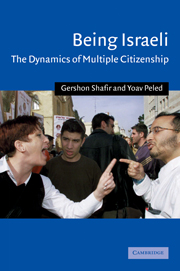Book contents
- Frontmatter
- Contents
- Acknowledgements
- List of abbreviations
- 1 Introduction
- Part 1 Fragmented citizenship in a colonial frontier society
- 2 The virtues of Ashkenazi pioneering
- 3 Mizrachim and women: between quality and quantity
- 4 The frontier within: Palestinians as third-class citizens
- 5 The wages of legitimation: Zionist and non-Zionist Orthodox Jews
- Part 2 The frontier reopens
- Part 3 The emergence of civil society
- Bibliography
- Index
- Cambridge Middle East Studies 16
4 - The frontier within: Palestinians as third-class citizens
Published online by Cambridge University Press: 05 June 2012
- Frontmatter
- Contents
- Acknowledgements
- List of abbreviations
- 1 Introduction
- Part 1 Fragmented citizenship in a colonial frontier society
- 2 The virtues of Ashkenazi pioneering
- 3 Mizrachim and women: between quality and quantity
- 4 The frontier within: Palestinians as third-class citizens
- 5 The wages of legitimation: Zionist and non-Zionist Orthodox Jews
- Part 2 The frontier reopens
- Part 3 The emergence of civil society
- Bibliography
- Index
- Cambridge Middle East Studies 16
Summary
The idea of autonomy for the Palestinians within the State of Israel simmers under the skin of the entire problem, hidden but present, threatening and suspicious like a false bottom that contains no one knows what, and gives a special resonance to every pronouncement heard as between the two peoples.
(Grossman 1992: 137)In 1948 the nature of the Jewish–Palestinian frontier struggle was radically transformed. The intercommunal conflict, which had taken place within the framework of British Mandatory rule, had now split into two: on the one hand, an international conflict between a number of hostile sovereign states and, on the other, an internal frontier struggle between the state of Israel and the Palestinians who had remained within its territory at the end of the 1948 war (Pappe 1992). These, the “1948 Palestinians,” and their offspring now count just under one million, constituting about 17 percent of the total population of Israel. (These figures do not include the approximately 170,000 Palestinians living in east Jerusalem, virtually all of whom are legal residents but not citizens of Israel.)
Oren Yiftachel has defined an internal frontier as “a region within a state where an ethnic minority forms a majority, and where the state attempts to expand its control over territory and inhabitants” (Yiftachel 1996: 496). In Israel the Palestinians are indeed concentrated in three geographical regions – the Galilee in the north, the “Triangle” in the east, and the Negev in the south – and, depending on how regional boundaries are drawn, they can be said to constitute a majority in at least the first two of these regions (see map in Yiftachel 1992: 64).
- Type
- Chapter
- Information
- Being IsraeliThe Dynamics of Multiple Citizenship, pp. 110 - 136Publisher: Cambridge University PressPrint publication year: 2002



